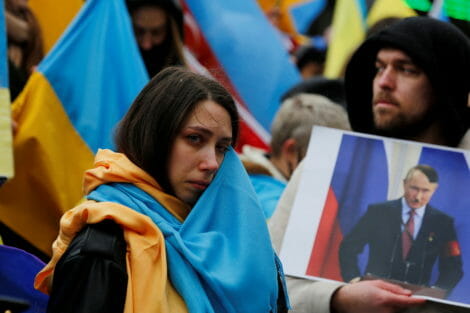TikTok war: How Russia’s invasion of Ukraine played to social media’s youngest audience

FILE PHOTO: A woman reacts as she takes part in an anti-war protest, following Russia’s invasion of Ukraine, in Istanbul, Turkey February 28, 2022. REUTERS/Dilara Senkaya/File Photo
When Russia invaded Ukraine last week, some of social media’s youngest users experienced the conflict from the front lines on TikTok.
Videos of people huddling and crying in windowless bomb shelters, explosions blasting through urban settings, and missiles streaking across Ukrainian cities took over the app from its usual offerings of fashion, fitness, and dance videos.
Ukrainian social media influencers uploaded bleak scenes of themselves wrapped in blankets in underground bunkers and army tanks rolling down residential streets, juxtaposed against photos of blooming flowers and laughing friends at restaurants that honored more peaceful memories of their hometowns.
They urged their followers to pray for Ukraine, donate to support the Ukrainian military, and demanded Russian users in particular to join anti-war efforts.
Russia’s invasion of Ukraine, which it has called a “special operation,” is the latest example of the central role TikTok has played in bringing news and current events to the app’s large Gen Z audience. Its famed algorithm is known for serving trending content even if users do not follow certain people, allowing topics to quickly go viral among its 1 billion monthly users.
The app has become so influential in this conflict that Ukrainian President Volodymyr Zelenskiy appealed to “TikTokers” as a group that could help end the war, in a speech directed at Russian citizens. Some TikTokers picked up where the politician left off.
A Ukrainian travel blogger named Alina Volik, who has over 36,000 followers on TikTok, took a break from posting highlights of her trips to Egypt, Spain, and Turkey, to upload videos of life in the invasion, of emergency backpacks filled with first aid supplies and of sealed windows to protect against glass shards in a blast. In TikTok videos posted on Monday, Volik also urged her international followers to watch her Instagram Stories to “see the truth” about Ukraine.
In an email to Reuters, Volik said she wanted to combat misinformation in the Russian news that the country’s actions were a “military operation” rather than a war that is hurting Ukrainians.
Montages of residential buildings destroyed by missiles, empty grocery store shelves, and long lines of cars piled up outside gas stations could be seen on the TikTok pages of top Ukrainian influencers.
“@zaluznik” who has 2 million followers, posted one such montage on Sunday with the caption “Russians open your eyes!”
Russian influencers have also taken to the app to share their reaction. Niki Proshin, who has over 763,000 TikTok followers, said in a video on Thursday that “normal people” in Russia do not support the war.
“None of my friends and none of the people I personally talk to supported today’s events,” he said, referring to the invasion of Ukraine.
On Monday, Russia’s communications regulator Roskomnadzor demanded the app stop including military-related content in recommended posts to minors, saying much of the content was anti-Russian in character. TikTok did not immediately respond to a request for comment.
Online misinformation researchers warned that false information about the conflict were now mixed in with authentic ones and has spread widely on TikTok and other tech platforms including Meta Platforms’ Facebook, Twitter, and Alphabet Inc’s YouTube.
Footage of military simulator video game Arma 3, images of explosions from the Israeli-Palestinian conflict in the Gaza Strip, old footage of heavy firing, and animations of flying aircraft have been shared on social media sites as if they depict the Russian invasion of Ukraine last week.
“We continue to closely monitor the situation, with increased resources to respond to emerging trends and remove violative content, including harmful misinformation and promotion of violence,” a TikTok spokesperson said, adding that it works with fact-checking organizations.
Some Ukrainian TikTok users have made it a mission to share information and spread awareness with Western audiences.
“I want people to understand this is not a joke, this is a serious situation that Ukrainians face,” Marta Vasyuta, 20, said in an interview on Monday.
One of Vasyuta’s TikTok videos showed what appeared to be a missile in the sky with the caption “Kyiv 4:23 am.” It had over 131,000 comments by Monday as users flooded the video to offer their prayers and express disbelief.
“Never thought I would get WAR updates on TIKTOK,” commented one user.
RELATED STORIES
‘Pick a side’: Ukraine invasion dilemma for US Big Tech
More than 100 civilians killed in Ukraine war, including seven children – UN